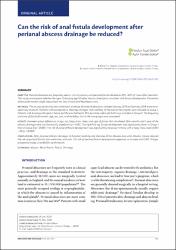| dc.contributor.author | Gökçe, Feridun Suat | |
| dc.contributor.author | Gökçe, Aylin Hande | |
| dc.date.accessioned | 2021-03-31T20:25:27Z | |
| dc.date.available | 2021-03-31T20:25:27Z | |
| dc.date.issued | 2020 | |
| dc.identifier.issn | 1806-9282 | |
| dc.identifier.uri | https://doi.org/10.1590/1806-9282.66.8.1082 | |
| dc.identifier.uri | https://hdl.handle.net/20.500.12900/39 | |
| dc.description | Gokce, Feridun Suat/0000-0001-8597-5787; Gokce, Aylin Hande/0000-0003-1908-2889 | en_US |
| dc.description | WOS:000568954700011 | en_US |
| dc.description | PubMed: 32935802 | en_US |
| dc.description.abstract | OBJECTIVE: Perianal abscesses are frequently seen in clinical practice, and perianal fistulas develop in 30%-50% of cases after treatment. This study investigated whether the type of dressing applied after abscess drainage is correlated with fistula development. Prevention of fistula formation would reduce both the loss of work and healthcare costs. METHODS: The records of patients who underwent drainage of perianal abscesses between January 2015 and January 2018 were retrospectively reviewed. Patients with postoperative dressings changed with washing of the area in the hospital were included as Group 1. Patients with dressings changed at home and the area bathed in 70% povidone-iodine sitz bath were included as Group 2. The frequency and time of fistula formation, age, sex, cost, and workdays lost in the two groups were compared. RESULTS: Between-group differences in age, sex, body mass index, and type of fistula that developed after months and 1 year of the abscess drainage were not statistically significant (p > 0.05). During follow-up, fistula development was significantly lower in Group 1 than in Group 2 (p < 0.001). The risk of perianal fistula development was significantly increased in those with a body mass index (BMI) > 30 (p = 0.004). CONCLUSIONS: After perianal abscess drainage, in-hospital washing and dressing of the abscess area until abscess closure reduced the risk of perianal fistula, lost work time, and cost. The risk of perianal fistula development appeared to increase with BMI. A large, prospective study is needed for confirmation. | en_US |
| dc.language.iso | eng | en_US |
| dc.publisher | Assoc Medica Brasileira | en_US |
| dc.rights | info:eu-repo/semantics/openAccess | en_US |
| dc.subject | Abscess | en_US |
| dc.subject | Rectal fistula | en_US |
| dc.subject | Fistula | en_US |
| dc.subject | Drainage | en_US |
| dc.title | Can the risk of anal fistula development after perianal abscess drainage be reduced? | en_US |
| dc.type | article | en_US |
| dc.department | İstanbul Atlas Üniversitesi, Tıp Fakültesi, Cerrahi Tıp Bilimleri Bölümü | en_US |
| dc.department-temp | [Gokce, Feridun Suat] Balikli Rum Hosp, Dept Gen Surg, Istanbul, Turkey; [Gokce, Aylin Hande] Istanbul Atlas Univ, Med Fac, Dept Gen Surg, Istanbul, Turkey | en_US |
| dc.contributor.institutionauthor | Gökçe, Aylin Hande | |
| dc.identifier.doi | 10.1590/1806-9282.66.8.1082 | |
| dc.identifier.volume | 66 | en_US |
| dc.identifier.issue | 8 | en_US |
| dc.identifier.startpage | 1082 | en_US |
| dc.identifier.endpage | 1086 | en_US |
| dc.relation.journal | Revista Da Associacao Medica Brasileira | en_US |
| dc.relation.publicationcategory | Makale - Uluslararası Hakemli Dergi - Kurum Öğretim Elemanı | en_US |

















